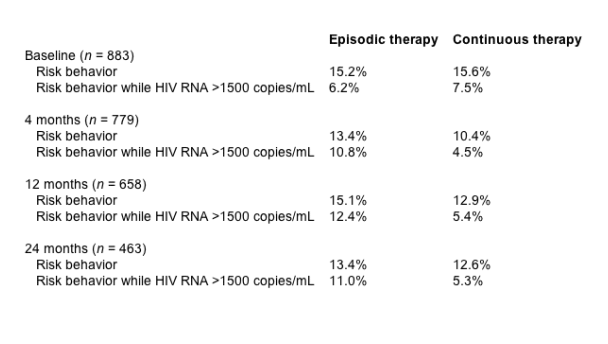 |
 |
 |
| |
HIV Transmission Risk is Higher During ART Interruptions
|
| |
| |
Reported by Jules Levin
CROI, Feb 2007, Los Angeles
The Effect of Episodic ART on HIV Transmission Risk: A Substudy of the SMART Study
The increased viral load resulting from interruption of ART could increase the risk of HIV transmission to partners. We compared HIV transmission risk in a subgroup of patients enrolled in the Strategies for Management of Antiretroviral Therapy (SMART) study, a randomized trial comparing CD4-guided episodic (stop >350 and start <250 cells/mm3) vs continuous ART.
At baseline, month 4 and 12, and annually, participants completed a written survey about sexual activity and needle-sharing in the prior 2 months and had testing for bacterial sexually transmitted infections (urine nucleic acid amplification testing for gonorrhea and chlamydia, serological testing for syphilis). Risk behavior was defined as self-reported vaginal or anal sex without a condom, self-reported needle-sharing, or an incident bacterial sexually transmitted infection. HIV transmission risk was defined as risk behavior while having an HIV RNA level >1500 copies/mL (the threshold for heterosexual transmission in the Rakai study).
The patients average age of 45, 25% were women, 46% were African-American and 52% said their risk factor for HIV was male-male sex. Sixteen per cent had shared needles.
Result:
883 patients were enrolled in the transmission risk substudy; the mean age was 45 years, 25% were women, and most (78%) were on ART at baseline. During follow-up, 95% of scheduled surveys were obtained; 1.9% of patients were lost to follow-up. At baseline, 136 of 883 (15.4%) reported recent needle-sharing or anal or vaginal sex without a condom or had gonorrhea or chlamydia. 58% had had sex of any kind over the previous two months but only 14% had had unprotected sex with someone who was or might have been HIV-negative while another 1.4% had shared needles with someone who was or may have been HIV-negative over the last two months. There was more risky behavior at baseline in the 62 patients naive to ART at trial entry: 20% of them had had risky behavior over the past 2 months compared with 14% of drug-experienced patients.
During follow-up, similar proportions of patients in the 2 arms had risk behavior (self-reported behavior or incident gonorrhea, chlamydia, or syphilis). However, a higher proportion of those reporting risk behavior in the episodic ART group had HIV RNA level >1500 copies/mL (p ²0.03 at all time points through 24 months). 6.85% of trial participants had had risky behavior during times their viral load was over 1,500 copies, a level considered a significant risk for HIV transmission.
Risk behavior was similar among patients randomized to episodic vs continuous ART. Because HIV RNA levels were higher overall among patients on episodic therapy, this strategy may result in increased HIV transmission to partners. In the table below patients on continuous therapy had half the amount of risky behavior on continuous therapy when VL was >1500 copies/ml compared to individuals taking interruptions when their VL was >1500 c/ml. Apparently this finding may have been driven by ART-naive patients. The study authors said because HIV levels were higher among patients interrupting therapy and appeared to demonstrate more risky behavior, therefore being off therapy increases the risk for HIV transmission.

|
| |
|
 |
 |
|
|